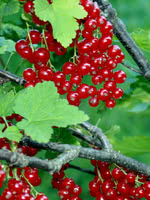Mon-Fri 9am - 5pm Mountain time
Western Snowberry vs Northern Red Currant
Symphoricarpos occidentalis
Ribes triste
NOT AVAILABLE THIS SEASON - MIGHT RETURN
NOT AVAILABLE THIS SEASON - MIGHT RETURN
Like the Common Snowberry, the Western Snowberry is a small shrub with pink flowers useful for feeding livestock and preventing erosion. Unlike the common species, however, the Western Snowberry is much more suited to wet conditions, capable of persevering through poor soil drainage and occasional flooding.
After the Snowberry's flowers have bloomed, it produces berries which often last on the plant through winter. These berries are toxic to humans, but livestock and local wildlife love them! Those hoping to attract wildlife to their property can plant Snowberry and expect to see animals foraging on it much later in the year than other plants.
The Northern Red Currant is also known as the Swamp Red currant due to its preference for moist soil. As long as the soil is wet, this shrub can live in any degree of sunlight.
The currant itself is a bright red-purple berry enjoyed by many animals and some people for its sour flavour, similar to garden red currants. The flowers of this shrub are tiny and red or greenish-purple.
Western Snowberry Quick Facts
Northern Red Currant Quick Facts
Toxicity: berries are toxic to humans

